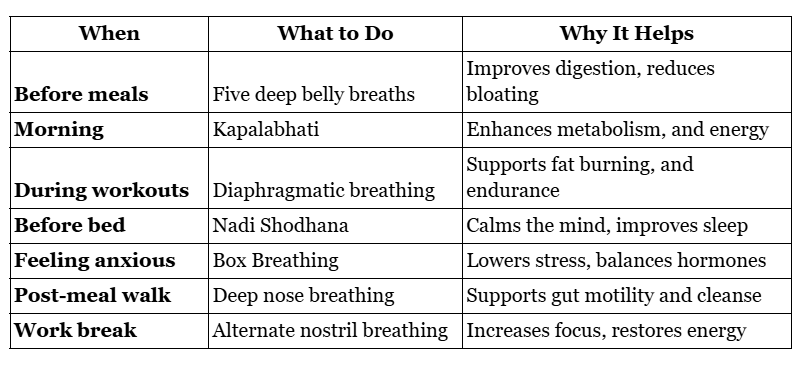One of the most common questions I get is: “Luke, I’m eating clean, and working out regularly, but the excess fat just won’t budge. What am I missing?”
Sometimes, the answer lies not in another supplement, diet fad, or gym session—but in something as simple and overlooked as your breath.
You see, fat burn doesn’t just happen with intense workouts or clean meals. It occurs when the body is in the right state. And that’s the rest-and-digest state. The parasympathetic mode.
But most of us are stuck in stress mode—rushing through meals, multitasking, breathing shallow—all of which slow down digestion and fat metabolism.

Digestion begins not in the stomach, but in the mouth. From the way you chew to the way you breathe.
Here, we’ll walk through how breath influences everything—from your gut health to your fat metabolism and even those sneaky cravings. You’ll also learn a few breathing techniques to use this powerful tool and support fat burn—naturally.
What do Most People Miss?
Breathing has a massive influence on everything—digestion, fat metabolism, energy, and even stress levels. Let’s break this down and see how making some changes to your breathing can unlock the results you’ve been missing.
Breath and Digestion: How Your Breath Affects Your Gut
We’ve all heard of the ‘fight-or-flight’ response and the ‘rest-and-digest’ state, but many don’t realize just how much it affects digestion.
Your body’s digestive functions thrive when you’re in a parasympathetic state—a calm, relaxed mode where your body is primed for digestion. This is often referred to as the rest-and-digest state.
However, when you’re stressed—whether it’s from work, screens, or simply eating too quickly—your body shifts into a sympathetic state (fight-or-flight mode). This triggers a series of hormonal changes, including an increase in cortisol, the stress hormone, which shuts down digestion.
You’ll experience:
- Reduced stomach acid production
- Slower gut motility
- Weakened enzyme activity
This all leads to sluggish digestion, bloating, gas, and poorly absorbed nutrients. You could be eating healthy, but your digestion is not functioning at its best.
The key to better digestion lies in shifting from sympathetic to parasympathetic. And the most effective way to do that is through deep, diaphragmatic breathing. Breathing techniques like pranayama for digestion have long emphasized how mindful breathing activates this healing state.
The Gut-Brain Axis
Your gut and brain are in constant communication via a two-way network known as the gut-brain axis. This system uses the vagus nerve as a primary communication line between your gut and your brain—and guess what modulates the vagus nerve? Your breath.
When you practice deep, diaphragmatic breathing techniques, you stimulate the vagus nerve, which sends calming signals to your brain and vice versa. This strengthens the parasympathetic (rest-and-digest) response and supports:
- Better secretion of digestive enzymes
- Improved peristalsis (better gut movement, helping food travel smoothly through your digestive system for optimal health)
- Reduced gut inflammation
- Enhanced absorption of nutrients

Incorporating simple breathing techniques like pranayama for digestion can help improve vagal tone, reduce stress, and create the optimal internal environment for nutrient breakdown and absorption. On the other hand, shallow, rapid breathing—a common sign of stress—weakens vagal tone, leading to poor communication between the brain and the gut.
Now let’s get into the science of fat burning.
Breath and Fat Burn: How Vitamin O Fuels Your Fat Cells
Fat oxidation is the process where your body uses fat stores as a fuel source, turning fat molecules into ATP (the energy currency of your cells). For this to happen, you need a good supply of Vitamin O (oxygen)—which means you need to breathe properly.
The Science: Fat + Oxygen = Energy (ATP)
For fat to be burned efficiently, your cells need oxygen. When you breathe shallowly (which is common in our stressful, fast-paced lives), you limit the oxygen supply to your cells. This, in turn, slows down your metabolism and makes fat burn less efficient.
Here’s where it gets interesting:
In my recent podcast with Anders Olsson, a leading breathing expert, shared that nasal breathing during low-intensity workouts activates fat reserves more effectively than mouth-breathing.
He emphasizes that shallow chest breathing (often associated with mouth-breathing) reduces oxygen intake and keeps your body in sugar-burning mode. This is why many people, even during their workouts, fail to access their fat stores for fuel.
Olsson explains how nasal breathing forces you to breathe slower, deeper, and more efficiently, increasing oxygen delivery to the cells. This creates the perfect environment for your body to utilize fat as fuel.
Shallow vs. Deep Breathing
Shallow breath (mouth-breathing) = Low oxygen = Slow fat burn
Deep breath (diaphragmatic breathing, nasal breathing) = High oxygen = Fast fat burn
So, if you’re wondering why your fat loss has plateaued, it might not be your nutrition or workout—it’s how you’re breathing.
Now, let’s get into the cellular level of fat burn.
Breath and Mitochondria: Cellular Insight into Fat Burn
Your body’s ability to burn fat is directly related to the performance of your mitochondria—the tiny powerhouses in your cells that convert fat into energy or adenosine triphosphate (ATP).
Mitochondria need oxygen to operate at full capacity. When you breathe deeply and supply your cells with more oxygen, you enable your mitochondria to produce more ATP from fat. This is why deep breathing can supercharge your fat metabolism.
In Ayurveda, there’s a concept of prana (life force) and agni (digestive fire). Prana is the energy that flows through us via the breath, and agni governs our digestion and metabolism. Without a strong flow of prana (oxygen), your agni (fat-burning ability) weakens.
Dr. Olsson also shared that low-intensity breathing techniques paired with proper breath control (nasal breathing) activate fat oxidation in a way that high-intensity training does not. When you’re working at a high intensity, especially when mouth-breathing, your body defaults to burning sugar, not fat.

Case Study: Nasal Breathing and Fat Loss
Here’s an inspiring case shared by Anders Olsson from the Swedish edition of The Biggest Loser (Biggest Loser Sverige), a reality show involving contestants attempting to lose weight. One of the contestants, who struggled with high-intensity workouts, started walking more regularly but focused on nasal breathing.
To everyone’s surprise, he ended up losing more weight than those pushing themselves through intense exercise sessions.
The key? Nasal breathing, which kept his body in fat-burning mode.
This is a perfect example of how sometimes, it’s not about intensity—it’s about strategy and getting the breathing right with discipline and consistency.
Connecting Breath, Gut Health, and Fat Loss
Now let’s bring this full circle. Poor digestion caused by stress and shallow breathing not only affects how you feel—it also slows down your metabolism and fat-burning capacity.
Here’s how:
- When digestion is poor, nutrient absorption drops. Your body gets fewer raw materials (vitamins, minerals, amino acids) needed for cellular energy and metabolic processes.
- When stress is high, and your gut is inflamed, the body becomes more insulin resistant, stores more fat, and craves sugar.
- Stress breathing (shallow, fast, or mouth breathing) tells your body to use sugar over fat as a fuel source. This blocks access to your fat reserves.
- When oxygen levels drop due to poor breathing, fat oxidation slows down, because fat needs more oxygen to be converted into usable energy (ATP).
Now that we have understood the basic science behind breathing, digestion, and fat burn, let’s explore some simple yet powerful breathing exercises to increase metabolism and pranayama for digestion.
Breathing Techniques to Increase Metabolism & Fat Burning
Here are a few breathing techniques for fat loss with step-by-step instructions and benefits:
1. Diaphragmatic Breathing (Belly Breathing)
Why it works: This breathing technique increases oxygen intake, which is critical for breaking down fat through oxidation. More oxygen = better fat metabolism. It is a perfect breathing exercise to increase metabolism.
How to do it:
- Sit comfortably with one hand on your belly and the other on your chest.
- Inhale through your nose, letting your belly expand like a balloon.
- Exhale slowly through your nose or mouth, letting the belly fall.
- The chest should stay relatively still.
- Do this for five minutes, ideally before meals or workouts.
2. Box Breathing (4-4-4-4 Method)
Why it works: Box breathing helps regulate the nervous system, improves oxygen use, and lowers cortisol. This is one of the perfect breathing techniques for people who feel anxious or emotionally hungry.
How to do it:
- Inhale for four seconds
- Hold your breath for four seconds
- Exhale for four seconds
- Hold your breath again for four seconds
- Repeat this for five to10 rounds, especially after a stressful day or before sleep
3. Kapalabhati (Skull-Shining Breath)
Why it works: This is one of the most energizing breathing techniques that stimulates the digestive fire (Agni) and promotes detoxification. It’s known to enhance fat oxidation and metabolism.
How to do it:
- Sit upright.
- Inhale gently.
- Forcefully exhale through the nose while pulling the belly in.
- Let the inhale be passive.
- Do 30–50 rounds in a session (avoid if you are pregnant or hypertensive).
- Do it on an empty stomach in the morning.
4. Alternate Nostril Breathing (Nadi Shodhana)
Why it works: This beautiful, calming breathing technique balances both hemispheres of the brain and regulates oxygen-carbon dioxide exchange. That balance is essential for efficient fat burn.
How to do it:
- Sit comfortably.
- Use your thumb to close the right nostril. Inhale through the left.
- Close the left nostril and exhale through the right.
- Inhale through the right nostril, close it, and exhale through the left. That’s one round.
- Do 10–15 rounds, slowly and mindfully. Best before sleep or meals.
You don’t need to carve out extra time or change your lifestyle. These are micro habits that fit beautifully into your day.
How to Incorporate Breathing Techniques for Fat Loss into Daily Life?

The Last Word…
Your body is intelligent. It’s always trying to bring you back to balance. But we interrupt it—with fast food, thoughts, and breathing.
Your breath is free. It’s always with you. And it could be the missing link in your journey of fat loss and better digestion.
I always say—breath is one of the six pillars of lifestyle and healing. Just like nutrition, movement, deep sleep, emotional well-being, and reconnecting with your spirit. They all work together.
So yes, breathe slowly. Eat mindfully. Live smart.
Looking for holistic and integrative guidance for fat loss the right way? We help you find a way.
Know more about our Weight Management Program here.
You can also book a consultation with our certified yoga experts and learn how to integrate the right breathing techniques into your lifestyle.
Or reach out to us at 1800 102 0253 or write to us at [email protected].
Team Luke
Start Your Wellness Journey
Feeling inspired to take the next step in your wellness journey? Connect with us to explore how our tailored programs can support your health journey. Your transformation is just a conversation away.


